Disclosure: Meeple Mountain received a free copy of this product in exchange for an honest, unbiased review. This review is not intended to be an endorsement.
Deep Blue is a deck-building, push-your-luck board game where players explore the seas in search of bountiful underwater wrecks. At a wreck site players dive for treasures, possibly earning them victory points, but have to do their best to manage the hazards (creatures and oxygen) that threaten their success. The player with the most victory points at the end of the game wins.
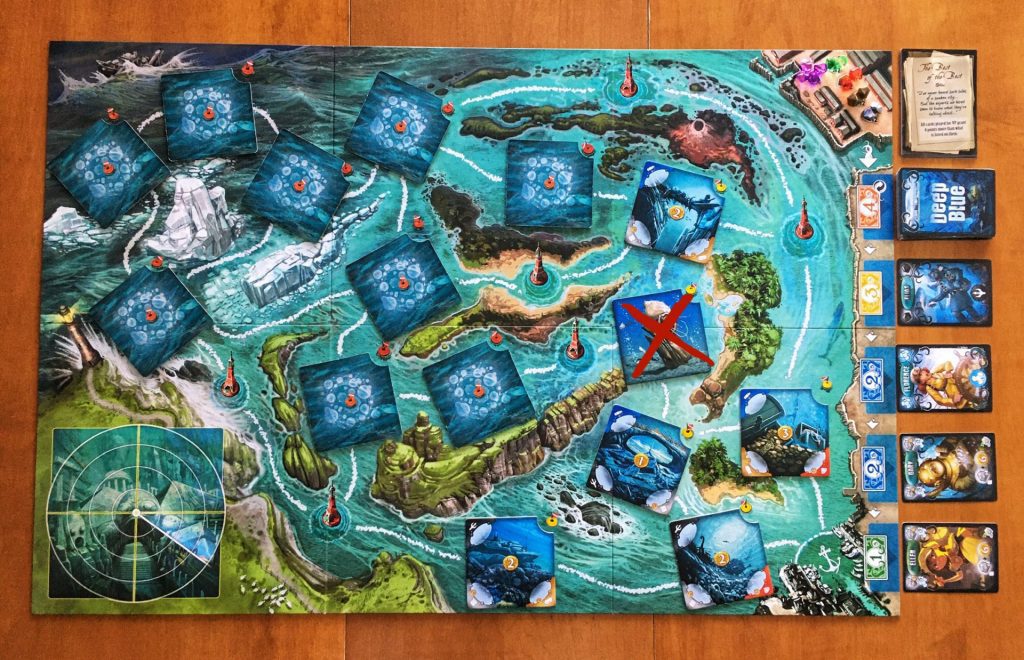
Gameplay
On a player’s turn they must perform one of the four possible actions: Recruit a Crew Member, Sail, Rest, or Dive.

Recruit a Crew Member
In Deep Blue, it’s important to build your deck. Each player starts with the same four Starting Crew cards, but with the Recruit a Crew Member action, players may improve their decks by hiring crew from the market. Crew members allow a player to score more points during dives, be protected from hazards, or travel further into the deep.

To Recruit, pay the price listed above the crew member in the market by playing as many cards from your hand with the cash icon and adding the acquired card to your hand. You are only allowed to hire one crew member per Recruit action so if you overspend, you won’t receive any benefit or change. Any cards you’ve played get discarded facedown on your player board’s resting crew area. After a crew member is recruited, the remaining cards in the market shift left, becoming less expensive for future recruitment.
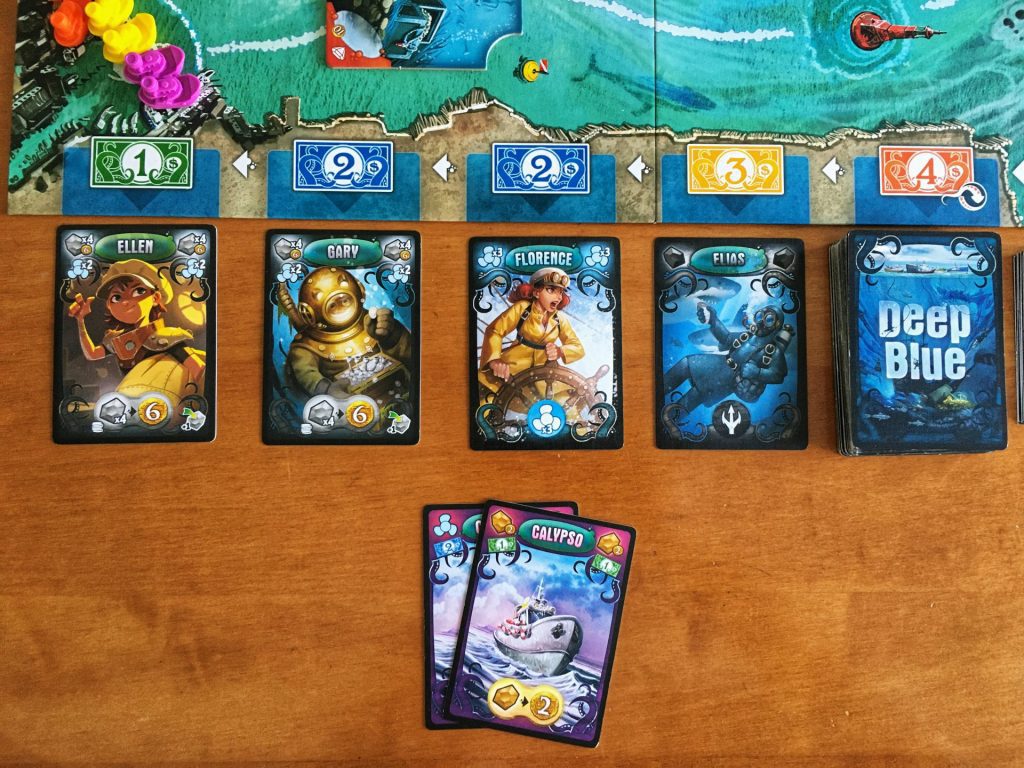
Sail
To Sail, play any number of cards from your hand with the propellor icon (pictured in the card’s corners). For each icon, you may move that many spaces on the game board, dividing the movement up freely amongst your two Boats if you wish. There is no restriction to how many Boats can occupy a single space or tile. Any cards you’ve played to Sail are also discarded facedown on your player board’s resting area. Once you have used your movement points, check where your Boats have ended up and do the following:
- On a faceup Wreck Tile: Place your Boat on an empty scouting spot (coloured corner of the tile) or on the centre of the tile if all spots are occupied by other Boats. A scouting spot gives you an advantage when you Dive there.
- On a facedown Wreck Tile: Reveal the tile and place your Boat on a scouting spot.
- On a navigational buoy or empty diving site: Do nothing.
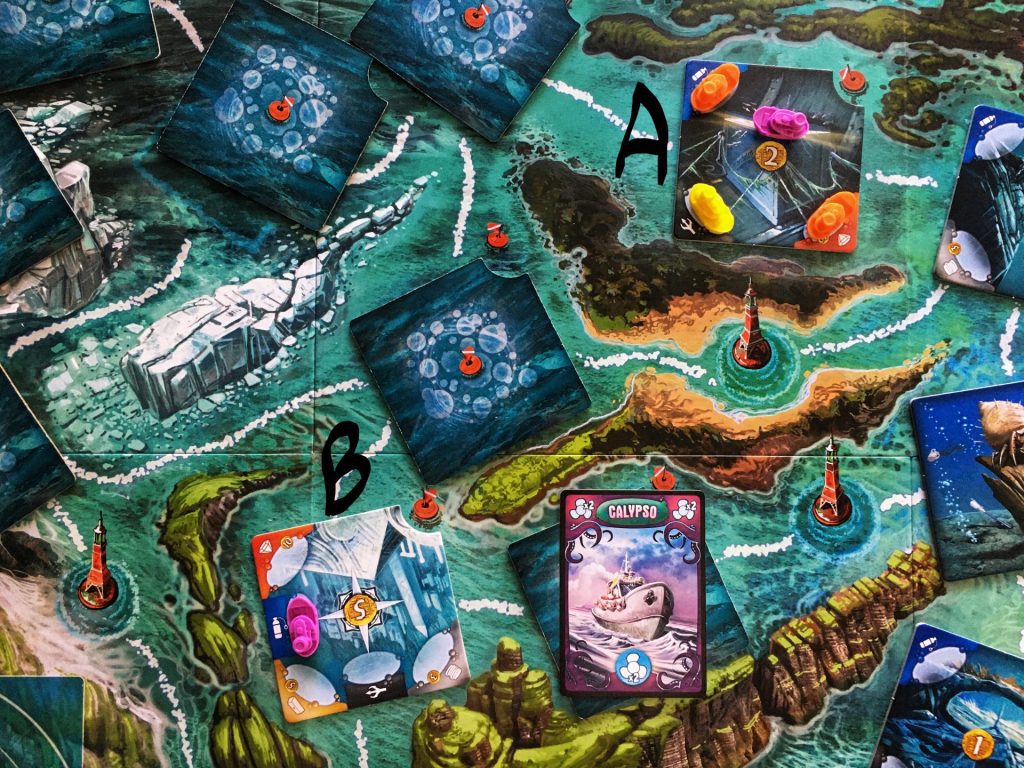
Rest
Shuffle the facedown cards in your resting crew area (discard pile) and draw three into your hand at random. The hand management in Deep Blue is quite clever; since you’re only returning three cards to your hand and you spend a turn to do so, the timing of this action is incredibly important. It also adds an element of uncertainty because you are never quite sure which cards your opponents are holding and how they might benefit from them during a Dive.
Dive
Diving is when the push-your-luck fun comes through in Deep Blue. To take a Dive action, one of your Boats must be on a Wreck Tile. If your Boats occupy two different Wreck Tiles, you must choose which one to Dive on. Any players who have Boats on adjacent spaces or tiles may rush to this dive site and join you. However, they may only place their Boats on the centre and not on a tile’s scouting spot, even if there are spots available.

Now the dive leader (the player who initiated the Dive) hunts for treasures, which is how players score victory points in Deep Blue. The dive leader draws a gem from the bag one at a time, placing each drawn gem on the Dive Site Board.
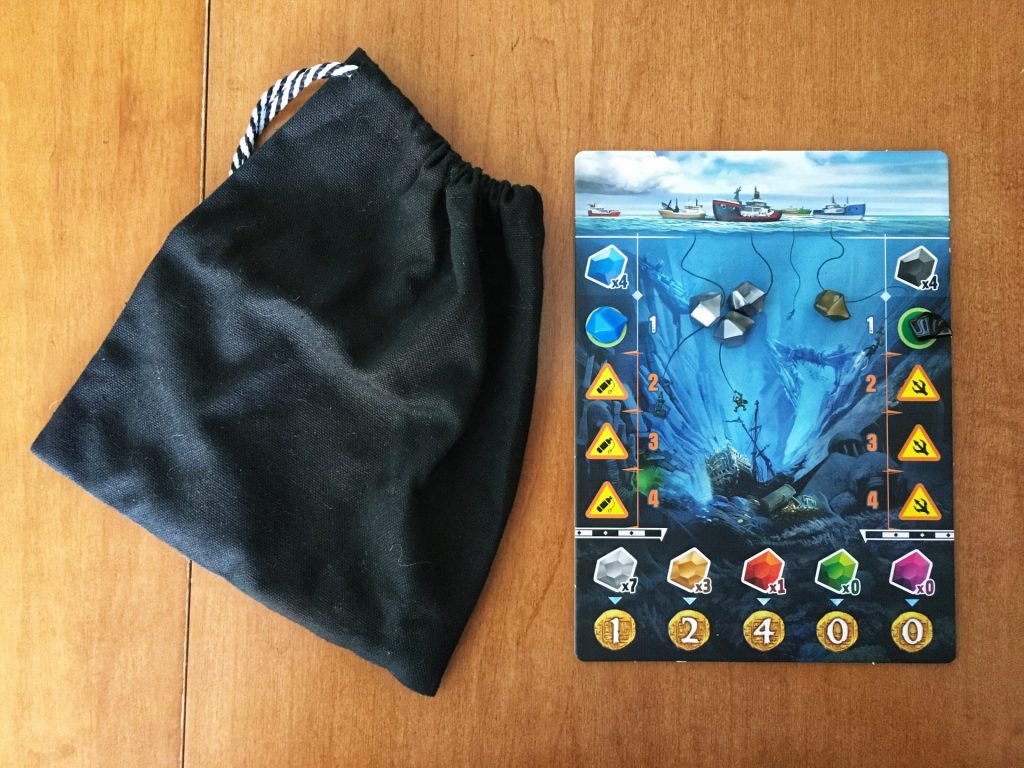
After a gem is drawn, the dive leader must decide whether they would like to end the dive or continue. Why might they end the dive? Well because there are hazards in the bag that might force them to end and also lose all their treasures (gems). Other players participating in the dive—regardless of if they were already present on the tile or rushed in—have no say in whether the dive leader ends the dive. They either reap the rewards or go down together.
The Gems
Speaking of rewards, let’s take a look at how victory points are earned. Victory points (VP), depicted as gold coins, are earned by drawing gems from the bag, playing a Crew card during a Dive, or initiating a Dive as the dive leader.
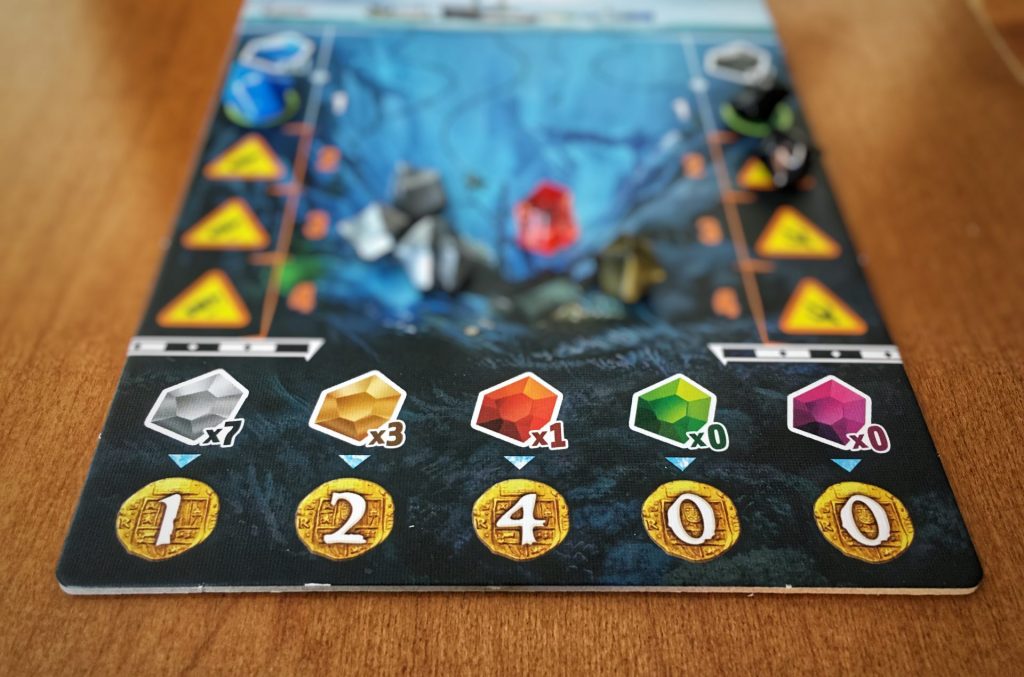
For each silver, gold, and red gem drawn from the bag, all participating players (the dive leader and others) earn the points listed on the Dive Site Board as pictured above. If a player has two Boats on a tile, they only earn the rewards once. Additionally, after each gem is drawn, players may play a Crew card from their hand if it meets the gem requirements on it, earning them even more points.

Some gems (purple and green) don’t score any points when drawn unless you play a Crew card to score them; only a player who plays the appropriate card earns these points. Initially the gem bag won’t have any green or purple gems in it, but as the Crew Member cards that score these gems are added to the market, so too are the corresponding gems added to the bag.

The black and blue gems represent hazards: sea creatures and oxygen problems. When one of these gems is drawn, it’s placed on its Dive Site Board space. The first hazard of each doesn’t affect the divers. However, to stay in the dive and earn rewards, players must defend against subsequently drawn hazards by playing cards from their hand or by using the hazard scouting spot that they occupy on the dive site tile. Each card or scouting spot may only defend against one gem (hazard).

Each player must defend against a hazard to continue to participate in the dive. If they cannot, they are forced to resurface, lose the chance to score VP for the drawn gems, and can no longer play Crew cards to score gems. They do still earn the VP for the cards they have already played during the dive. Sometimes, because of a poor draw for example, it makes sense to save a card and not defend against a hazard. You may choose to resurface, forfeiting the same benefits as though you were forced to end your dive. The dive leader always defends against a hazard first and, if they are not able to, the dive ends and players collect their VP. If possible, the other players may still defend against this final hazard to secure more points for themselves.
Scoring Dives and Gaining Victory Points
All players who joined the dive get VP for their played Crew cards, even if they resurfaced. Any players who didn’t resurface also earn points for each gem drawn from the bag (1/2/4 for each silver/gold/red gem). If a player’s Boat was on a scouting spot for silver, gold, or red gems they instead earn 3, 5, or 10 VP respectively for each. Finally the dive leader earns the points shown on the centre of the tile, regardless of how their dive ended.

Then all played cards are discarded to players’ resting crew area, all gems are returned to the bag, and the Wreck Tile is removed from the game.
Sunken City Tiles
There are four special Sunken City Tiles in Deep Blue. These tiles generally feature more scouting spots, better dive leader bonuses, and have special diving rules to follow. In each game one Captain’s Log Scenario card is used to determine the special rules to follow when diving on a Sunken City Tile only.
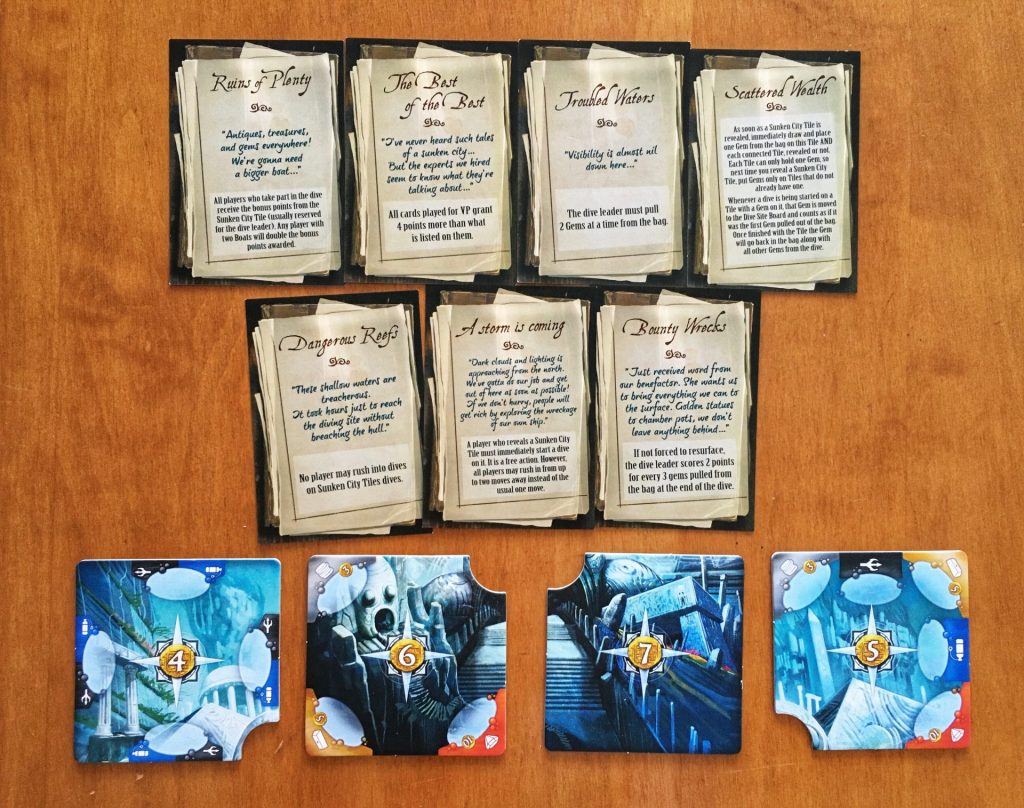
After a Dive on a Sunken City, the tile is placed on the dedicated area of the game board instead of discarded. Once a Dive has been performed on all four Sunken City Tiles, the game ends and the player with the most VP wins.
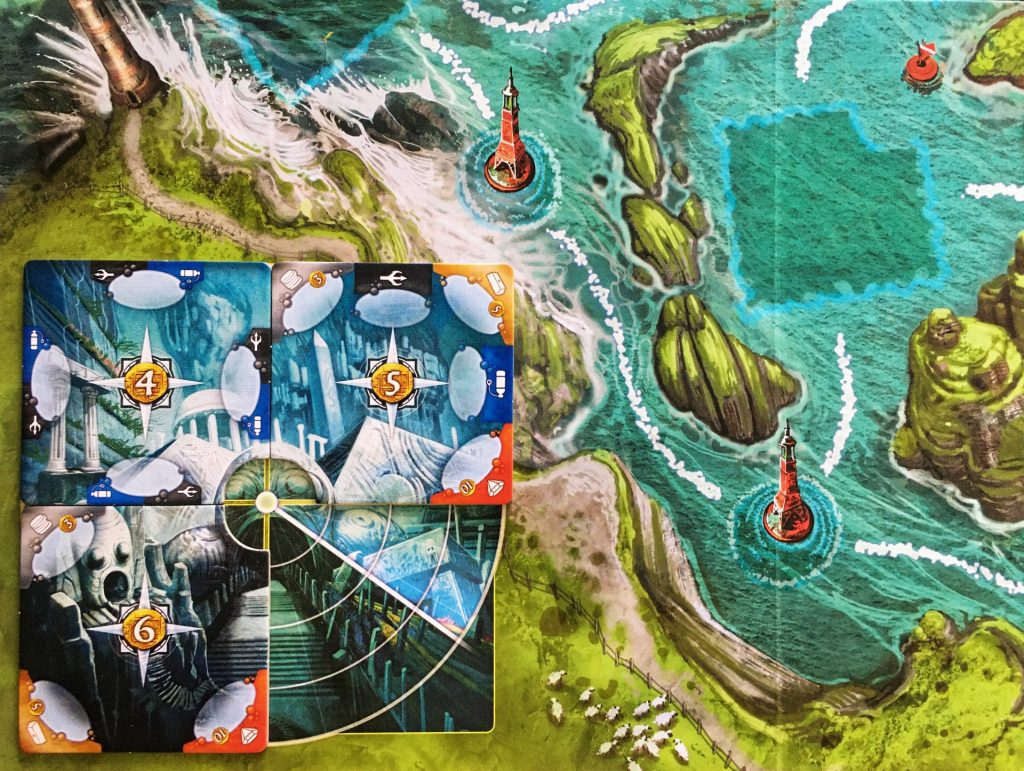
Final Thoughts
Deep Blue is gorgeous, which isn’t surprising considering Days of Wonder seems to fine-tune every detail of their game’s production. The board is vibrant and colourful, yet all the important information is clear and not lost in unnecessary aesthetic details. The component quality is also top-notch: from the extravagant player treasure chests to store VP to the game’s functional insert. Days of Wonder has always known how to make a stunning game.
With that, I have to say I found one of their choices very curious indeed: the gold and silver gems look almost identical, especially when its counterpart hasn’t been drawn from the bag to compare. In every game I’ve played, players have had to announce when they draw a silver or gold gem because of how similarly they are coloured. It’s surprising because it feels like even translucent yellow gems like the red, green, and purple ones included in the game could have worked as a “gold gem”.
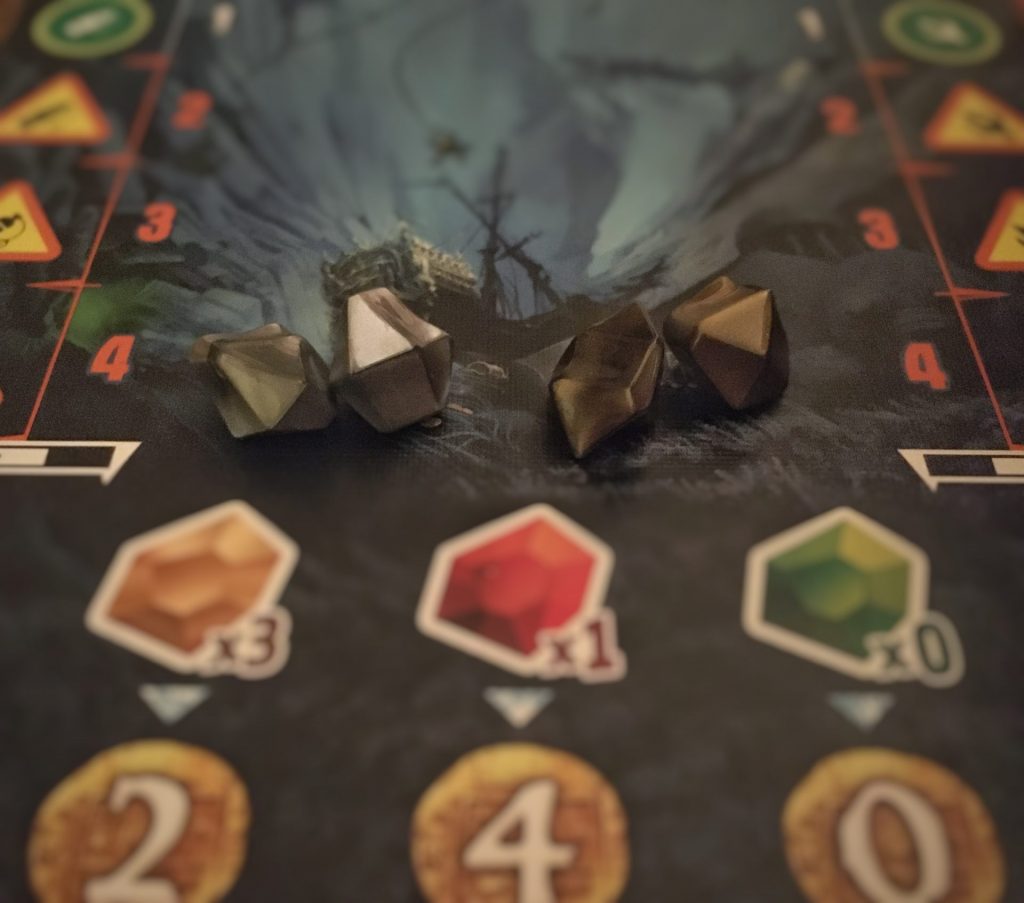
Deep Blue plays from two to five players. With higher player counts, there is more player interaction when it comes to the dives, simply because the odds that other players are adjacent to your dive site increase. Even though there is no scaling of the board when playing with fewer than five, the experience with two players was surprisingly more interactive than I expected it to be (and we weren’t just exploring our own corner of the board as I thought would be the case). This was particularly true near the end of the game when we both knew how important it was to get in on those final Sunken City dives.
Before I played Deep Blue, I had heard pretty lackluster (even negative) critiques from the review community. Once I finally got a chance to play, I felt frustrated — frustrated by the fact that we, as reviewers, sometimes disregard the good parts of a game simply because overall it isn’t a huge success. Not every new release will jump to the top of the BoardGameGeek ranks or be the new hotness and that’s okay. We have programmed ourselves to expect every game to be unique, creating unrealistic expectations to then only be disappointed when games can’t meet them. While I have had a great time whenever I’ve played Deep Blue, I don’t know that this is a game with staying power in our flooded industry. This is hard for me to admit, especially since Deep Blue has no obvious mechanical flaws. The game is just positioned in this weird (and unfortunate) space where it doesn’t out-compete its competitors. Nevertheless, Deep Blue has some neat design elements that deserve to be celebrated.
Deep Blue, by design, increases player interaction in a way which feels natural; you aren’t playing take-that cards to mess with your opponents or getting in each other’s way just for the sake of blocking someone. In Deep Blue, players are encouraged to dive together and keep their Boats close to other players’ because doing so scores you more points. In general a dive leader wants a high-scoring dive so it’s to your advantage to jump in with them, especially if you have cards in hand to score those rare green and purple gems or fend off hazards. Occasionally, a dive leader might intentionally tank a dive if they don’t want their opponents scoring more points than them, but this is the risk you take as a player who rushes in. Incidentally, it’s also the risk you take as a dive leader because you could also come out of the dive with very few VP.
There is also a real incentive for you to push your luck in Deep Blue because of how points are divided between scoring for gems drawn from the bag (VP which you might lose if you’re forced to resurface) and scoring cards from your hand (guaranteed VP once that card is played). Not to mention the scouting spots really tempt you into pushing your luck, whether it be because you are on a high-scoring gem space or because you have so many hazard defenses at your disposal. Sometimes push-your-luck games are missing this incentive to push forward, encouraging players to earn huge rewards or fail horribly.
Another game which does this well is The Quacks of Quedlinburg: near the end of the game you might have 9 chips in your bag, one of which will make your potion explode, but all the others will help you advance to more points, more buying power, and maybe even a ruby. When a game urges you to go big, the payout is really exciting. When you bust you feel terrible, but it’s these moments which create lasting gaming memories and are highlights in game logs.
Finally, Deep Blue deserves to be applauded for its take on hand management: knowing when it’s worth it to play a card and when to use the Rest action. Do you play out most of the cards from your hand, only resting when you’ve run out? In doing so, you risk another player starting a dive on a tile with your Boat since they know you’re at their mercy with no Crew cards to play for guaranteed points. You also risk having to take multiple Rest actions when you don’t get your best movement card the first time around. What if, instead, you played a max of three cards before taking a Rest action? You would guarantee those played cards would return to your hand, but then you might waste more turns resting for cards that might not be worth it or, even worse, resting at an opportune time to take advantage of a Wreck Tile as the dive leader. It’s this kind of hand management and these simple, yet thoughtful choices which make Deep Blue’s gameplay shine.
Deep Blue might not be pushing its way into the Top 100 anytime soon, but it is still a solid family game with some deck-building and push-your-luck elements as well as the incredible Days of Wonder production we’ve come to love and appreciate.
Thematic Music for Playing Deep Blue
Blue Planet II (Original Television Soundtrack) by Hans Zimmer, Jacob Shea, and David Fleming
Songs to check out include: Mobula Rays, Big Blue, Humboldt Squid, and Walrus: The Right Piece of Ice.
Digital Shades Vol. 1 by M83
Songs to check out include: Waves Waves Waves, My Own Strange Path, By The Kiss, and The Highest Journey.
More info on M83: http://ilovem83.com/
Underwater & Ocean Themed Video Game Music Volume 1 & Volume 2
Volume 2 is my preferred compilation and it would be perfect if not for missing Aquatic Ambiance from Donkey Kong Country.


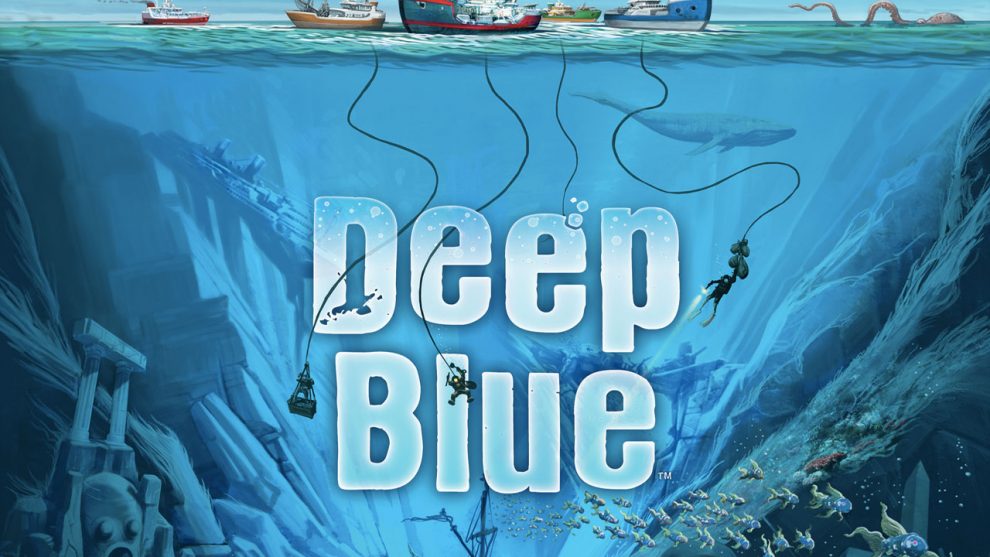








Add Comment